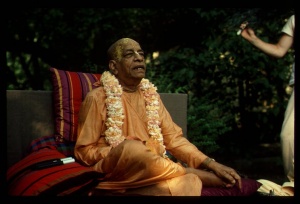CC Antya 1.134: Difference between revisions
m (1 revision(s)) |
No edit summary |
||
| Line 1: | Line 1: | ||
{{ | [[Category:Sri Caitanya-caritamrta - Antya-lila Chapter 01|C134]] | ||
<div style="float:left">'''[[Sri Caitanya-caritamrta|Śrī Caitanya-caritāmṛta]] - [[CC Antya|Antya-līlā]] - [[CC Antya 1|Chapter 1: Śrīla Rūpa Gosvāmī's Second Meeting With the Lord]]'''</div> | |||
<div style="float:right">[[File:Go-previous.png|link=CC Antya 1.133|Antya-līlā 1.133]] '''[[CC Antya 1.133|Antya-līlā 1.133]] - [[CC Antya 1.135|Antya-līlā 1.135]]''' [[File:Go-next.png|link=CC Antya 1.135|Antya-līlā 1.135]]</div> | |||
{{CompareVersions|CC|Antya 1.134|CC 1975|CC 1996}} | |||
{{RandomImage}} | |||
==== TEXT 134 ==== | ==== TEXT 134 ==== | ||
<div class="verse"> | |||
<div | :rāya kahe,—“kon āmukhe pātra-sannidhāna?” | ||
rāya kahe,—“kon āmukhe pātra-sannidhāna?” | :rūpa kahe,—“kāla-sāmye ‘pravartaka’ nāma“ | ||
rūpa kahe,—“kāla-sāmye ‘pravartaka’ nāma“ | |||
</div> | </div> | ||
| Line 13: | Line 16: | ||
==== SYNONYMS ==== | ==== SYNONYMS ==== | ||
<div class="synonyms"> | |||
<div | ''rāya kahe''—Rāmānanda Rāya says; ''kon''—what; ''āmukhe''—by introduction; ''pātra-sannidhāna''—presence of the players; ''rūpa kahe''—Śrīla Rūpa Gosvāmī replies; ''kāla-sāmye''—in agreement of time; ''pravartaka nāma''—the introduction called ''pravartaka''. | ||
rāya | |||
</div> | </div> | ||
| Line 21: | Line 23: | ||
==== TRANSLATION ==== | ==== TRANSLATION ==== | ||
<div class="translation"> | |||
<div | Rāmānanda Rāya inquired, "How have you introduced the assembly of the players?" | ||
Rāmānanda Rāya inquired, | Rūpa Gosvāmī replied, "The players assemble at a suitable time under the heading of pravartaka. | ||
Rūpa Gosvāmī replied, | |||
</div> | </div> | ||
==== PURPORT ==== | ==== PURPORT ==== | ||
<div class="purport"> | |||
In a drama all the actors are called ''pātra'', or players. This is stated by Viśvanātha Kavirāja in the ''Sāhitya-darpaṇa'' (6.283): | |||
:''divya-martye sa tad-rūpo miśram anyataras tayoḥ'' | |||
:''sūcayed vastu-bījaṁ vāmukhaṁ pātram athāpi vā'' | |||
The meaning of ''āmukha'' is stated by Śrīla Rūpa Gosvāmī in the ''Nāṭaka-candrikā'': | |||
: | |||
:''sūtra-dhāro naṭī brūte sva-kāryaṁ pratiyuktitaḥ'' | |||
:''prastutākṣepi-citroktyā yat tad āmukham īritam'' | |||
When Śrīla Rāmānanda Rāya inquired about the arrangement for introducing the assembly of players in the drama, Rūpa Gosvāmī replied that when the players first enter the stage in response to the time, the introduction is technically called ''pravartaka''. For an example, see verse 136 below. Śrīla Bhaktisiddhānta Sarasvatī Ṭhākura says that the introduction, which is technically called ''āmukha'', may be of five different kinds, according to the ''Sāhitya-darpaṇa'' (6.288): | |||
: | |||
:''udghātyakaḥ kathodghātaḥ prayogātiśayas tathā'' | |||
:''pravartakāvalagite pañca prastāvanā-bhidāḥ'' | |||
: | "Introductions may be classified as follows: (1) ''udghātyaka'', (2) ''kathodghāta'', (3) ''prayogātiśaya'', (4) ''pravartaka'' and (5) ''avalagita''." These five kinds of introduction are called ''āmukha''. Thus Śrīla Rāmānanda Rāya asked which of the five introductions had been employed, and Śrīla Rūpa Gosvāmī replied that he had used the introduction called the ''pravartaka''. | ||
</div> | |||
<div style="float:right; clear:both;">[[File:Go-previous.png|link=CC Antya 1.133|Antya-līlā 1.133]] '''[[CC Antya 1.133|Antya-līlā 1.133]] - [[CC Antya 1.135|Antya-līlā 1.135]]''' [[File:Go-next.png|link=CC Antya 1.135|Antya-līlā 1.135]]</div> | |||
</div> | __NOTOC__ | ||
__NOTOC__ | __NOEDITSECTION__ | ||
Revision as of 09:35, 11 September 2021

A.C. Bhaktivedanta Swami Prabhupada
TEXT 134
- rāya kahe,—“kon āmukhe pātra-sannidhāna?”
- rūpa kahe,—“kāla-sāmye ‘pravartaka’ nāma“
SYNONYMS
rāya kahe—Rāmānanda Rāya says; kon—what; āmukhe—by introduction; pātra-sannidhāna—presence of the players; rūpa kahe—Śrīla Rūpa Gosvāmī replies; kāla-sāmye—in agreement of time; pravartaka nāma—the introduction called pravartaka.
TRANSLATION
Rāmānanda Rāya inquired, "How have you introduced the assembly of the players?" Rūpa Gosvāmī replied, "The players assemble at a suitable time under the heading of pravartaka.
PURPORT
In a drama all the actors are called pātra, or players. This is stated by Viśvanātha Kavirāja in the Sāhitya-darpaṇa (6.283):
- divya-martye sa tad-rūpo miśram anyataras tayoḥ
- sūcayed vastu-bījaṁ vāmukhaṁ pātram athāpi vā
The meaning of āmukha is stated by Śrīla Rūpa Gosvāmī in the Nāṭaka-candrikā:
- sūtra-dhāro naṭī brūte sva-kāryaṁ pratiyuktitaḥ
- prastutākṣepi-citroktyā yat tad āmukham īritam
When Śrīla Rāmānanda Rāya inquired about the arrangement for introducing the assembly of players in the drama, Rūpa Gosvāmī replied that when the players first enter the stage in response to the time, the introduction is technically called pravartaka. For an example, see verse 136 below. Śrīla Bhaktisiddhānta Sarasvatī Ṭhākura says that the introduction, which is technically called āmukha, may be of five different kinds, according to the Sāhitya-darpaṇa (6.288):
- udghātyakaḥ kathodghātaḥ prayogātiśayas tathā
- pravartakāvalagite pañca prastāvanā-bhidāḥ
"Introductions may be classified as follows: (1) udghātyaka, (2) kathodghāta, (3) prayogātiśaya, (4) pravartaka and (5) avalagita." These five kinds of introduction are called āmukha. Thus Śrīla Rāmānanda Rāya asked which of the five introductions had been employed, and Śrīla Rūpa Gosvāmī replied that he had used the introduction called the pravartaka.